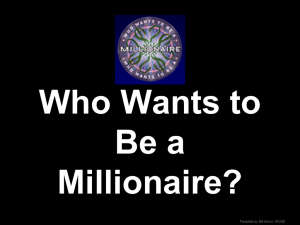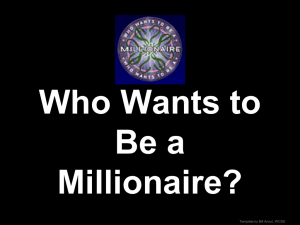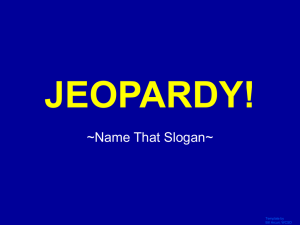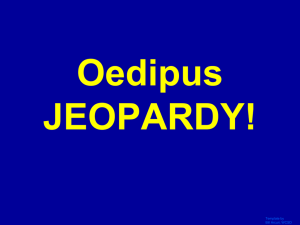jeopardy!
advertisement
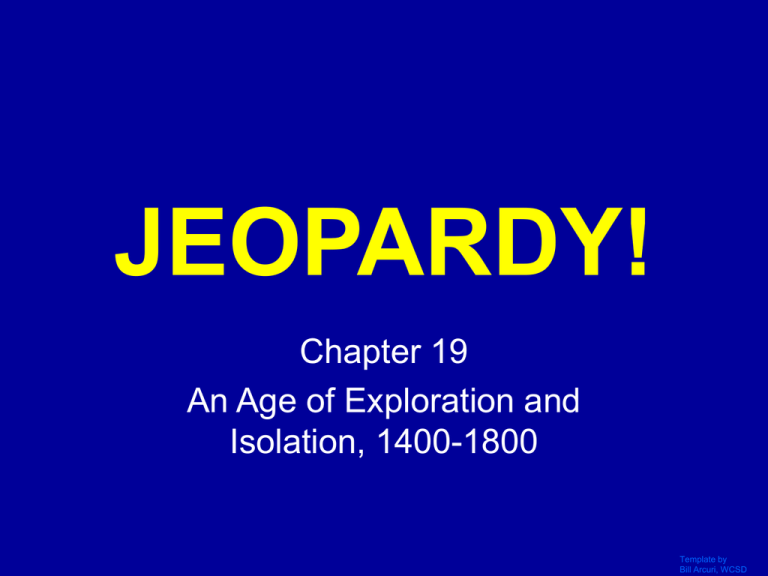
JEOPARDY! Click Once to Begin Chapter 19 An Age of Exploration and Isolation, 1400-1800 Template by Bill Arcuri, WCSD JEOPARDY! Europeans Europeans Europeans Chinese Chinese Japanese 1 2 3 4 5 6 100 100 100 100 100 100 200 200 200 200 200 200 300 300 300 300 300 300 400 400 400 400 400 400 500 500 500 500 500 500 Template by Bill Arcuri, WCSD This European nation’s East India Company dominated Indian th Ocean trade by the 17 century Template by Bill Arcuri, WCSD This Portuguese st captain became the 1 to sail around the southern tip of Africa Template by Bill Arcuri, WCSD This European nation took the lead in navigation and overseas exploration Template by Bill Arcuri, WCSD The Line of Demarcation established a boundary between which two European regions claims to new lands Template by Bill Arcuri, WCSD This European country profited the most from trade with the East in the years directly following the Crusades Template by Bill Arcuri, WCSD This was the most important trade good from the East during the 1400s Template by Bill Arcuri, WCSD He successfully sailed from Portugal to India in 1498 Template by Bill Arcuri, WCSD The two primary reasons for European exploration Template by Bill Arcuri, WCSD This gave the Europeans the ability to sail against the wind Template by Bill Arcuri, WCSD This ancient Greek invention gave Europeans the ability to determine their location based on the sun and stars Template by Bill Arcuri, WCSD The new sea-worthy ship that the Portuguese used to sail the open sea Template by Bill Arcuri, WCSD He led the Portuguese research institute at Sagres Template by Bill Arcuri, WCSD This man was convinced that one could reach Asia by sailing west and tried to prove his theory correct in 1492 Template by Bill Arcuri, WCSD The Pope drew this imaginary line in 1494 in an attempt to settle land disputes between Spain and Portugal Template by Bill Arcuri, WCSD This Spanish adventurer was credited with being the st 1 to circumnavigate the globe in 1521 Template by Bill Arcuri, WCSD This son of peasants founded the Ming Dynasty Template by Bill Arcuri, WCSD This ruler moved the Chinese capital to Beijing, where he built the Forbidden City Template by Bill Arcuri, WCSD This Chinese explorer led seven voyages of exploration to SE Asia, India, Arabia, and E. Africa Template by Bill Arcuri, WCSD The Qing Dynasty was founded by a member of this group Template by Bill Arcuri, WCSD This dynasty included the rulers Kangxi and Qianlong Template by Bill Arcuri, WCSD This dynasty rules China following the end of Mongol rule Template by Bill Arcuri, WCSD This Chinese ruler attempted to expand China’s tribute system by sponsoring voyages of exploration Template by Bill Arcuri, WCSD This nation’s trade representatives won the favor of Chinese emperors by accepting restrictions on trade, paying tribute, and kowtowing Template by Bill Arcuri, WCSD This emperor ruled China for 60 years and was popular because he lowered farmers taxes and gave government jobs to intellectuals Template by Bill Arcuri, WCSD This Chinese dynasty was founded in the mid1600s Template by Bill Arcuri, WCSD They were the Japanese equivalent of feudal lords in medieval Europe Template by Bill Arcuri, WCSD This military government reunified Japan in 1600 Template by Bill Arcuri, WCSD This form of drama became very popular among the Japanese elite Template by Bill Arcuri, WCSD This Japanese form of poetry does not express ideas, but presents images Template by Bill Arcuri, WCSD Tokugawa Ieyasu used this policy of ‘hostage taking’ to control Japanese daimyos Template by Bill Arcuri, WCSD

